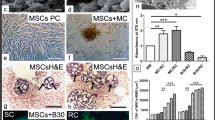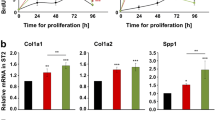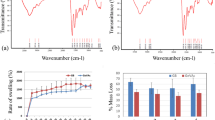Abstract
Objectives
This study evaluated hyaluronic acids (HA) with different molecular weights as potential matrices for tissue-engineered bone grafting and their possible influence on the paracrine mechanisms of adipose-derived mesenchymal stromal cells.
Material and methods
Murine adipose mesenchymal stromal cells (mASCs) on the fourth passage were seeded in 96-well plates, osteoinduced for 27 days and exposed for 3 days to low (HA-LW) and high/low molecular weight (HA-HLW) at previously defined concentrations. Cytokines IGF-1, VEGF, FGF-2, and BMP-2 were evaluated by quantification in the supernatant.
Results
Greater expression of growth factors was observed in groups with HA-HLW compared to HA-LW. Results indicated that differentiated cells secreted fewer cytokines, namely VEGF, FGF, and BMP-2 than undifferentiated mASCs (p < 0.05). IGF-1 showed its greatest expression in the mASC HA-LW group (p < 0.05).
Conclusions
The application of HA-HLW as cell matrix in tissue engineering did not compromise mASC paracrine effect. Also, the association of HA-HLW matrix and mASCs resulted in greater expression of osteogenic growth factors. Longer periods of cell differentiation seemed to negatively affect their capacity for local paracrine stimulation.
Clinical relevance
The use of HA-HLW as matrix for undifferentiated ASCs can be positive for bone regeneration, favoring its application as cell matrix in bone grafting procedures.



Similar content being viewed by others
References
Shanbhag S, Shanbhag V (2015) Clinical applications of cell-based approaches in alveolar bone augmentation: a systematic review. Clin Implant Dent Relat Res 17 Suppl 1:e17–e34
Egusa H, Sonoyama W, Nishimura M, Atsuta I, Akiyama K (2012) Stem cells in dentistry--part II: clinical applications. J Prosthodont Res 56(4):229–248
Shanbhag S, Stavropoulos A, Suliman S, Hervig T, Mustafa K (2017) Efficacy of humanized mesenchymal stem cell cultures for bone tissue engineering: a systematic review with a focus on platelet derivatives. Tissue Eng Part B Rev 23(6):552–569
Keshtkar S, Azarpira N, Ghahremani MH (2018) Mesenchymal stem cell-derived extracellular vesicles: novel frontiers in regenerative medicine. Stem Cell Res Ther 9(1):63
Madrigal M, Rao KS, Riordan NH (2014) A review of therapeutic effects of mesenchymal stem cell secretions and induction of secretory modification by different culture methods. J Transl Med 12:260
Dimitriou R, Mataliotakis GI, Angoules AG et al (2011) Complications following autologous bone graft harvesting from the iliac crest and using the RIA: a systematic review. Injury 42 Suppl 2:S3–S15
Delloye C, Cornu O, Druez V et al (2007) Bone allografts: what they can offer and what they cannot. J Bone Joint Surg (Br) 89(5):574–579
Kaku M, Akiba Y, Akiyama K, Akita D, Nishimura M (2015) Cell-based bone regeneration for alveolar ridge augmentation--cell source, endogenous cell recruitment and immunomodulatory function. J Prosthodont Res 59(2):96–112
Schwartz Z, Goldstein M, Raviv E, Hirsch A, Ranly DM, Boyan BD (2007) Clinical evaluation of demineralized bone allograft in a hyaluronic acid carrier for sinus lift augmentation in humans: a computed tomography and histomorphometric study. Clin Oral Implants Res 18(2):204–211
Dicker KT, Gurski LA, Pradhan-Bhatt S, Witt RL, Farach-Carson MC, Jia X (2014) Hyaluronan: a simple polysaccharide with diverse biological functions. Acta Biomater 10(4):1558–1570
Collins MN, Birkinshaw C (2013) Hyaluronic acid-based scaffolds for tissue engineering--a review. Carbohydr Polym 92(2):1262–1279
Meirelles LS, Nardi NB (2003) Murine marrow-derived mesenchymal stem cell: isolation, in vitro expansion, and characterization. Br J Haematol 123(4):702–711
Guo J, Guo S, Wang Y, Yu Y (2017) Adipose-derived stem cells and hyaluronic acid based gel compatibility, studied in vitro. Mol Med Rep 16(4):4095–4100
Agolli E, Diffidenti B, Di Zitti N et al (2018) Hybrid cooperative complexes of high and low molecular weight hyaluronans (Profhilo®): review of the literature and presentation of the VisionHA project. Esperienze Dermatologiche 20(1):5–14
Boeckel DG, Sesterheim P, Peres TR et al (2019) Adipogenic mesenchymal stem cells and hyaluronic acid as a cellular compound for bone tissue engineering. J Craniofac Surg 30(3):777–783
Mambelli LI, Santos EJC, Frazão PJR, Chaparro MB, Kerkis A, Zoppa ALV, Kerkis I (2009) Characterization of equine adipose tissue-derived progenitor cells before and after cryopreservation. Tissue Eng Part C Methods 15(1):87–94
Strem BM, Hicok KC, Zhu M, Wulur I, Alfonso Z, Schreiber RE, Fraser JK, Hedrick MH (2005) Multipotential differentiation of adipose tissue-derived stem cell. Keio J Med 54(3):132–141. https://doi.org/10.2302/kjm.54.132
Kern S, Eichler H, Stoeve J (2006) Comparative analysis of mesenchymal stem cells from bone marrow, umbilical cord blood, or adipose tissue. Stem Cells 24(5):1294–1301
Bobis S, Jarocha D, Majka M (2006) Mesenchymal stem cells: characteristics and clinical applications. Folia Histochem Cytobiol 44(4):215–230
Meirelles LS, Fontes AM, Covas DT et al (2009) Mechanisms involved in the therapeutic properties of mesenchymal stem cells. Cytokine Growth Factor Rev 20(5-6):419–427
Phinney DG, Prockop DJ (2007) Concise review: mesenchymal stem/multipotent stromal cells: the state of transdifferentiation and modes of tissue repair--current views. Stem Cells 25(11):2896–2902
Prockop DJ, Oh JY (2012) Mesenchymal stem/stromal cells (MSCs): role as guardians of inflammation. Mol Ther 20(1):14–20
Vieira S, Vial S, Reis RL, Oliveira JM (2017) Nanoparticles for bone tissue engineering. Biotechnol Prog 33(3):590–611
Hughes FJ (2015) Periodontium and periodontal disease. In: Vishwakarma A, Sharpe P, Shi S (eds.) Stem cell biology and tissue engineering in dental sciences, 1st edn. Academic Press, Massachussets, pp 433–444. https://doi.org/10.1016/B978-0-12-397157-9.00038-2
Misawa M, Lindhe J, Araújo MG (2016) The alveolar process following single-tooth extraction: a study of maxillary incisor and premolar sites in man. Clin Oral Implants Res 27(7):884–889
Chappuis V, Araújo MG, Buser D (2017) Clinical relevance of dimensional bone and soft tissue alterations post-extraction in esthetic sites. k 73(1):73–83
David-Raoudi M, Tranchepain F, Deschrevel B (2008) Differential effects of hyaluronan and its fragments on fibroblasts: relation to wound healing. Wound Repair Regen 16(2):274–287
Averbeck M, Gebhardt CA, Susanne Voigt S et al (2007) Differential regulation of hyaluronan metabolism in the epidermal and dermal compartments of human skin by UVB irradiation. J Invest Dermatol 127(3):687–697
Stern R, Asari AA, Sugahara KN (2006) Hyaluronan fragments: an information-rich system. Eur J Cell Biol 85(8):699–715
D'Agostino A, Stellavato A, Busico T et al (2015) In vitro analysis of the effects on wound healing of high- and low-molecular weight chains of hyaluronan and their hybrid H-HA/L-HA complexes. BMC Cell Biol 16:19
Stellavato A, La Noce M, Corsuto L et al (2017) Gianpaolo Papaccio, Chiara Schiraldi, Virginia Tirino. Hybrid complexes of high and low molecular weight hyaluronans highly enhance hascs differentiation: implication for facial bioremodelling. Cell Physiol Biochem 44(3):1078–1092
Lu C, Saless N, Wang X (2013) The role of oxygen during fracture healing. Bone 52(1):220–229
Kim J, Kim IS, Cho TH (2017) Bone regeneration using hyaluronic acid-based hydrogel with bone morphogenic protein-2 and human mesenchymal stem cells. Biomaterials 28(10):1830–1837
Einhorn TA (1998) The cell and molecular biology of fracture healing. Clin Orthop Relat Res (355 Suppl):S7–S21
Shoji T, Li M, Mifune Y (2010) Local transplantation of human multipotent adipose-derived stem cells accelerates fracture healing via enhanced osteogenesis and angiogenesis. Lab Investig 90(4):637–649
Funding
The present study was supported by grants from the International Team for Implantology (ITI) Foundation (No. 1155_2016), Switzerland, and by the National Council for Scientific and Technological Development (CNPq), Brazil.
Author information
Authors and Affiliations
Corresponding author
Ethics declarations
Conflict of interest
The authors declare that they have no conflict of interest.
Ethical approval
The present study protocol followed national and institutional guidelines for the care and use of animals and was approved by the Animal Research Ethics Committee of the Pontifical Catholic University of Rio Grande do Sul, Brazil (CEUA_1471005851428).
Informed consent
The present study does not require formal informed consent.
Additional information
Publisher’s note
Springer Nature remains neutral with regard to jurisdictional claims in published maps and institutional affiliations.
Rights and permissions
About this article
Cite this article
Cabreira, C.L., Fulginiti, R.L., Sesterheim, P. et al. Effect of hyaluronic acid on paracrine signaling of osteoblasts from mesenchymal stromal cells: potential impact on bone regeneration. Clin Oral Invest 25, 4571–4578 (2021). https://doi.org/10.1007/s00784-020-03771-x
Received:
Accepted:
Published:
Issue Date:
DOI: https://doi.org/10.1007/s00784-020-03771-x




